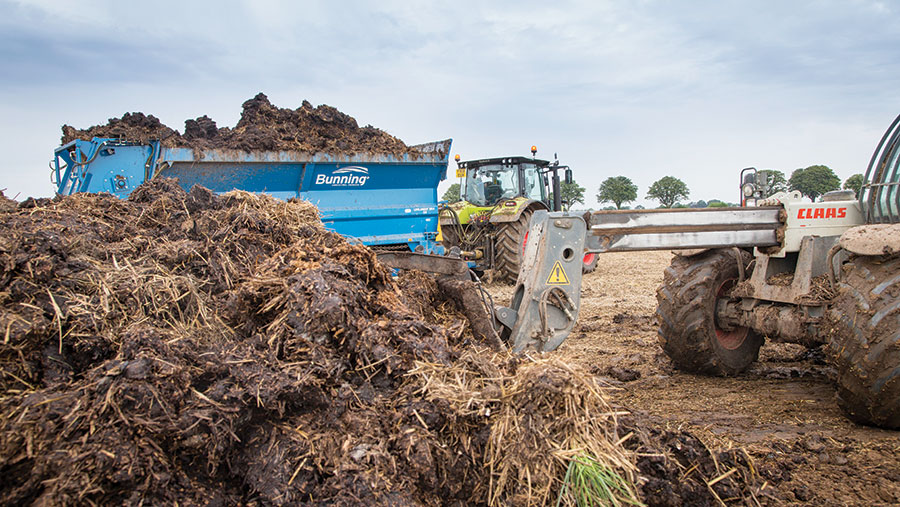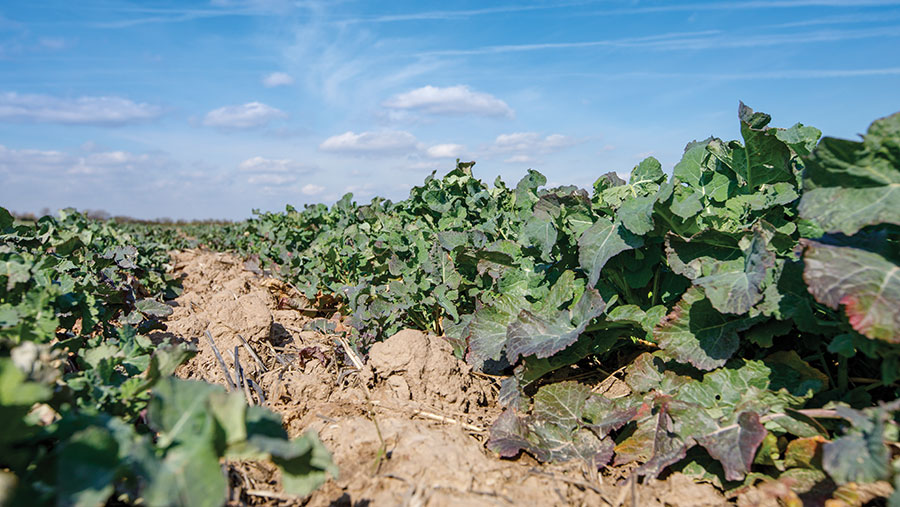How Yen growers delivered monster OSR and cereal yields
 © Gary Naylor
© Gary Naylor A winter wheat crop by Lincolnshire grower Mark Stubbs yielded 16.3t/ha to take the top prize in the Adas-organised Yield Enhancement Network (Yen) competition in 2019.
Following good use of tissue tests, Mr Stubbs’ crop of Siskin achieved 85% of its full yield potential. East Yorkshire entrant Richard Wainwright came second, with a yield of 15.2t/ha, with Oxfordshire grower David Passmore taking third place with 14.8t/ha.
All three winners included farmyard manure, grew their winning crops after oilseed rape and have a policy of prioritising soil health and good soil structure.
See also: How grain analysis can help farmers hit wheat protein specs
Plenty of muck and near-perfect weather at its coastal location were the reasons given by Mr Stubbs for his success. He entered the wheat competition for the first time this year with a commercially grown crop.
Reassuringly, given the current season, the crop was drilled on 4 November at a seed rate of 513 seeds/sq m. His practice of getting nitrogen on as soon as possible in February helped to get it growing strongly and develop a good root structure, with a total of 230kg/ha of N being applied in four splits.
Nature or nurture?
The Adas team behind the Yen competition has identified the weather factors that are associated with high yields, but stress that the yield variation associated with seasonal factors is less than that associated with farmers and farm factors.
Pete Berry, head of crop physiology, has looked at the influence Mother Nature has on final results, going back as far as 1970, to understand more about the effect of weather on yields.
In wheat, there are four parameters, which together account for 30% of yield variation:
1. Dry November Gives better plant establishment from minimal waterlogging
2. Cool May Results in better tiller retention and lower respiration
3. Cool 21 June to 11 July Brings improved fertility and grain set, less respiration
4. Non-windy July Reduces lodging
In oilseed rape, there are five factors, which together account for 37% of yield variation:
1. High maximum temperature in October Leads to strong autumn growth
2. Dry December Results in less waterlogging, 50mm below average rainfall give 0.11t/ha more yield
3. High minimum temperature in March Stops any checks to growth
4. Sunny/dry April Prevents excessive canopy growth, with 50mm less rain giving 0.2t/ha extra yield
5. Cool/wet/dull May Gives better seed set

© Gary Naylor
“Given the uptake of Yen by growers and their willingness to collect and share data, we now have some very useful insights,” says Sarah Kendall of Adas.
Dr Kendall adds that large cereal yields come from large crops, which have more ears than average and tend to be taller. Husbandry factors that matter include:
- Following a break crop
- Narrow drill widths
- Applying slurry
- Adequate N use
- Several plant growth regulator applications
“However, it isn’t all about how much you spend on them – it’s attention to detail,” she says. “The cereal Yen shows high-yielding crops are associated with high ear numbers and high final biomass, which are carefully managed.”
The OSR Yen demonstrates the need to maximise seed number and have a focused approach to inputs. Higher yields come from a longer period between flowering and desiccation, as well as greater use of fungicides and plant growth regulators, but fewer herbicides.
“With the exception of this year’s winner, higher yields also tend to come from crops grown at lower seed rates,” she says.
Low disease pressure and good varietal resistance meant three fungicides were used at T1, T2 and T3, with two applications of plant growth regulator.
“The weather was perfect,” he says. “Growing it near the coast meant the sea frets kept temperatures 5C lower than inland areas, and we had good sunlight for much of the time.”
The silver gong went to Farmers Weekly Farmer Focus writer Mr Wainwright, with a crop of Graham, which reached 88% of its yield potential.
Drilled on 18 October at a seed rate of 275kg/ha, his crop received a total of 325kg/ha of N in six applications and four fungicides, at a cost of £106/ha, in an approach he describes as “kitchen sink farming”.
“The trouble with this is that if it doesn’t yield, for whatever reason, you’re in trouble,” he says. “We did it for the Yen entry, as we’re on the cusp of learning more about crop nutrition. Otherwise, the farm’s cost of production for wheat is pegged at £80/t.”
Nutrition focus
The new focus for Yen will be crop nutrition, with the intention to look at soil, tissue and grain nutrient levels and develop thresholds for 12 nutrients.
“We know that magnesium in the soil and the seed, phosphate in the seed and iron in the seed are all associated with high yields,” says Adas’ Sarah Kendall.
Half of the crops entered into Yen are deficient in P, while only 27% of crops have no deficiencies.
“There’s more to learn and we’re looking forward to working with our Yen farmers to expand our nutrition knowledge and develop best practice.”
Bronze went to Mr Passmore in Oxfordshire for a crop of Kerrin, which achieved 80% of its potential on a chalky Grade 3 soil.
Sown on 1 October at a seed rate of 350kg/ha, Mr Passmore’s crop also received 230kg/ha of N in four applications. Good use of pig manure and getting the basics right were the reasons he gave for its success, which was achieved despite the crop having a below-average number of ears/sq m .
“It compensated for that by having a higher number of grains,” he reports. “These Yen crops can be high risk, so I used four fungicides at a cost of £123/ha and three plant growth regulators.”
Best potential wheat yield
Scottish grower Donald Ross took the top accolade for best percentage of potential yield, with a 12.8t/ha crop of Skyscraper that managed to hit 93% of its potential.
Lots of muck and an extended autumn helped his 5 October-drilled crop put on good early growth, while five splits of nitrogen and three applications of potash were used – an approach Mr Ross has developed by learning from previous Yen reports.
Mr Wainwright was second, with 88% of a 17.4t/ha yield potential, while a first-time entry from Kaido Kirst in Estonia took third place with 86% of 11.3t/ha.
Regional awards – Highest yield of cereals
- Scotland David Bell, Fife: 14.3t/ha
- North Richard Wainwright, North Yorkshire: 15.2t/ha
- East Midlands Mark Stubbs, Lincolnshire: 16.3t/ha
- East Anglia John Benton, Norfolk: 12.8t/ha
- West Andrew Williamson, Shropshire: 11.8t/ha
- South East David Passmore, Oxfordshire: 14.8t/ha
- South West Mark Doble, Somerset: 14.3t/ha
- Non-UK Hubert Rijk, the Netherlands: 13.2t/ha
Oilseed rape, barley and innovation awards
A record-breaking oilseed rape yield of 7.19t/ha saw Kent grower Richard Budd win the OSR Yen competition this year, also taking the best potential yield award with 85% of 8.4t/ha.
His crop of Campus was grown on virgin land using home-saved seed and wasn’t drilled until 14 September, at a seed rate of 7.5kg/ha, with a target of getting 60 plants established/sq m.
Grown after wheat and established by strip-till, the crop had very little trouble from flea beetle and received Mr Budd’s standard herbicide programme of Centurion Max (clethodim) and Kerb (propyzamide). Two applications of fungicides and plant growth regulators were made, while 230kg/ha of N went on in three splits.
Late drilling, high sunlight levels and a kind winter all helped, Mr Budd believes, although he also credits regular tissue testing, plenty of luck and close attention to detail.
His approach is to develop a large crop canopy, dominated by the main raceme. His Yen entry was grown using the farm’s standard programme, rather than receiving additional inputs.
Second and third places were taken by Richard Wainwright and Mark Stubbs – who were both also successful in the wheat competition, and grew DK Exclaim, using mid- to late August drilling dates.
Mr Wainwright’s OSR yielded 6.82t/ha and was a monster crop from day one, so his strategy was to keep it greener for longer. The exposed location kept the flea beetles away, while his annual use of cattle muck meant it only required one 40kg/ha N application.
He credits early drilling (17 August), the use of muck and luck with the weather for the very high yield, but also points out that he didn’t desiccate the crop. He also took silver for the best percentage of potential yield, with 72% of 9.4t/ha.
Mr Stubbs ended up with a yield of 6.77t/ha from a crop drilled on 27 August at a seed rate of 45 seeds/sq m. Shot holing from flea beetle feeding was evident, he reveals, but early spring nitrogen helped the crop to grow away.
A good, but uneven, canopy allowed maximum light interception, with the flowering period extending to eight weeks. “Having entered the oilseed rape Yen before, I used the information from the reports to fine-tune my approach.”
David Fuller-Shapcott in Roxburghshire received bronze in the potential yield category, with 63% of 10.1t/ha. Growing the hybrid INV1035, he aimed for a low plant population and kept the canopy going – possibly helped by the desiccation spray being washed off soon after application.
Spring barley
The first-ever spring barley Yen award was won by Alex Wilcox from Norfolk with a yield of 10.7t/ha. He also took the title for best percentage of potential yield, with 72% of 14.9t/ha.
His crop of Laureate was drilled on 15 January at a rate of 235seeds/sq m (127kg/ha) and received 110kg/ha of N in two splits, two fungicides and one plant growth regulator. Manganese and boron were also applied.
Mr Wilcox uses both organic manures and soil conditioners, having seen spring barley performance drop by 2t/ha on new land that hadn’t been improved.
“I want spring barley to stop being the poor relation,” he says. “That can mean treating it more like a winter barley and getting it to set big ears, so I’ve been tinkering with its agronomy.”
The grain N in the winning crop was 1.8. “I have reduced N use from 140kg/ha to 110kg/ha and will probably trim that back to 100kg/ha this year,” he says.
Innovation awards
Peter Chapman from South Redbog Farm, Strichen, Aberdeenshire, was the well-deserved recipient of the Innovator of the Year Award.
This award recognises his efforts at initiating the Scottish Yen growers group, driving the spring barley competition and developing ideas to achieve crop momentum.
Commendations went to David Fuller-Shapcott of Roxburghshire, Chris Eglington of Norfolk and Ed Horton of Gloucestershire.

